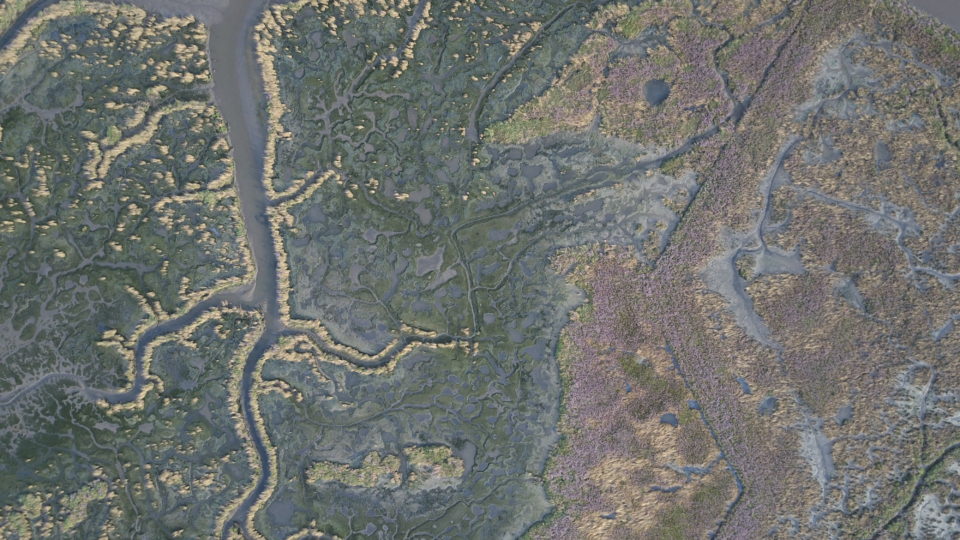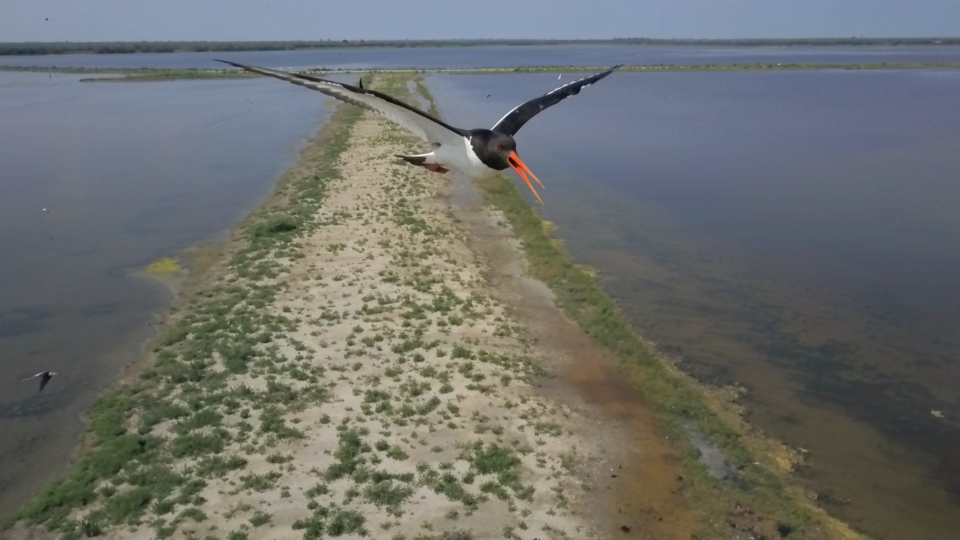Spotlight: Drone vs. human surveys of breeding shorebirds
Can machines replace humans?
Article authored by Deborah Buehler
It’s a thought-provoking question. Especially at moment when machines – and algorithms more broadly – are increasingly impacting our lives1. However, one might understandably say that further clarification is needed. What type of machines? What task is to be done?
In this issue of Wader Study, Roberto Valle and Francesco Scarton highlight the nuanced way this question could be answered2. Of course, they don’t ask whether machines can replace humans, exactly. They just want a safe and accurate way to count nesting shorebirds and they wonder if machines might help. In this case, the machines are unmanned aerial systems, also known as ‘drones’, a name that may be an onomatopoeia for the mosquito-like noise they make. Drone technology can be useful as well as annoying. Many fields of study have used drones from military intelligence, to civil engineering, to archaeology, to mining; and wildlife biology is no exception3. If you had to count something, in inhospitable territory, wouldn’t you send in the drones?
Valle and Scarton needed to count breeding pairs of their study species, Black-winged Stilts Himantopus himantopus and Pied Avocets Recurvirostra avosetta. These birds make nests in difficult-to-reach saltmarshes in the Lagoon of Venice, a 55,000 ha coastal wetland in northeastern Italy. The lagoon is the largest in the Mediterranean Sea and the area is full of soft mud and tidal channels, both of which are easier to fly a drone over than to walk on.

Saltmarshes in the Lagoon of Venice in northeastern Italy (photo: Roberto Valle)
However, before sending in the drones, Valle and Scarton needed to know that the technology could accurately and safely count the birds. Therefore, they compared the safety and effectiveness of drone-conducted counts with traditional ground-based counts.
The researchers conducted fieldwork from mid-April to mid-June during the 2017 and 2018 breeding seasons. Surveys were restricted to days with windspeeds less than 10 km/h and no clouds because, although human researchers often work in wind and rain, drones require better weather. Drone and ground surveys took place at 52 colonies over the two years, always either in the morning from 8 am to 10 am or in the afternoon from 4 pm to 6 pm to avoid extreme temperatures.
The safety of the birds was top priority, especially since drones are a newer technology. Therefore, the researchers launched drones from sites more than 150 m from the study colony and then flew at a height of 70m until they were directly above the centre of the colony. This ensured that the drone wouldn’t disturb the birds before the survey had started. Much like humans, birds don’t like it when things plummet vertically towards them. For this reason, the researchers used the “lawn mower” pattern, systematically flying back and forth, to lower the drones when it was time to begin the survey.
Once the drone was lowered to about 30m, the pilot could see the nests, but couldn’t be certain whether there was a bird present at the nest. Thus, the researchers lowered the drone a further 10 to 20 m. At this height, they flew above the nests at a speed of 15 to 30 km per hour, causing any birds to flush (fly away) from their nests. Disturbing the birds was necessary to record reactions to the drone. These reactions were coded in the field or later from videos as follows: birds sitting on or flushing from a nest were considered a breeding pair, birds strongly reacting to the drone by chasing it were considered probable breeders, even if far from a nest, and the researchers counted one pair for every two birds behaving this way.
During each drone flight, a researcher observed the colony from approximately 150 m to check whether nests or young were in danger of predation after the adults were flushed from the nests. Thirty minutes later the researchers approached the colony on foot for the ground survey. During a ground survey, two researchers walked abreast about 10 m apart systematically searching for nests. Every nest with eggs or chicks was recorded as ‘confirmed breeding’.
Ground surveys were always done after drone surveys even though the researchers admit that this is a limitation in terms of the comparison of methods. A completely fair comparison would have randomized the order of the surveys. However, in this study, randomization was intentionally traded for the ability to use the ground survey as a safety check on the preceding drone survey.
The researchers found no evidence that drone surveys cause undue disturbance to birds. Birds were not scared permanently from their nests, nor were the nests exposed to predators. In fact, the drones caused less disturbance to the birds than humans on the ground. Drone surveys also took less researcher time, even accounting for post-processing work in the lab after drone surveys.
Drones were therefore safe and efficient, but were they accurate? Unfortunately, no. Valle and Scarton found that fewer breeding pairs were identified during drone flights than ground counts. This undercounting was substantial, with 18.1% of Black-winged Stilt pairs and 20.5% of Pied Avocet pairs missed during the drone surveys. Furthermore, drone surveys had less sensitivity (true breeding pairs identified as positive), specificity (true non-breeders identified as negative), and accuracy (correctly identified birds divided by the total birds seen).
This study shows that there are pros and cons to using drones when surveying nesting shorebirds. Drones did not detect as many nests as ground surveys and falsely identified some nests; however, the drone surveys caused less disturbance to the birds. These results raise the question of whether accuracy could be improved with improved drone technology or whether drones could be useful under some, if not all, circumstances?
Valle and Scarton admit that a limitation of their study was the type of drone used. It was a simple model with a standard camera. A larger drone with a higher quality camera might have provided better images and allowed the researchers to distinguish incubating birds from a higher altitude without flushing them from nests. This might improve accuracy while further decreasing disturbance to the birds, but this remains to be tested.
The researchers also found that the size and composition of the breeding colony mattered. In large, mixed colonies, birds flushed when the drone was still quite far away in response to alarm calls from only a few species. For example, the presence of Eurasian Oystercatchers Haematopus ostralegus made this worse because they are very aggressive towards drones. This contributed to undercounting because it was more difficult to identify breeding pairs when the adults were no longer at their nests. Furthermore, if nesting birds were flushed out of sight of the drone pilot, they weren’t counted. The opposite was also a problem, if the same bird repeatedly chased the drone, within the line of sight, it could be double counted.

Eurasian Oystercatcher reacting to drone. (photo: Roberto Valle)
Knowing that large, multi-species colonies contributed to errors in the drone surveys, the authors asked whether drones might be most useful for smaller colonies of mainly silts and avocets. This was indeed the case. The authors found that both the sensitivity and specificity of the drone surveys were increased in small colonies and that in these circumstances there was nearly perfect agreement between the drone and ground survey methods.
So, can machines replace humans? It’s a question best answered with context taken into account. In this study, the machines are drones and the task is counting breeding shorebirds. The authors recommend the use of drones only in small colonies without species, like Eurasian Oystercatchers, that react more strongly to drones. In these circumstances, drones provide high accuracy, low disturbance, and shorter time to complete a survey. In other circumstances, the authors do not recommend the use of drones.
More broadly, context becomes even more important when asking whether, when and how machines might replace humans. Our world is full of technologies that were unimaginable less than a generation ago. Yet we use these technologies daily and they affect all aspects of our lives4. Machines can do many things better than humans, but there remain many things that humans can do better than machines. We can be empathetic, we can question our own biases, we can use our humanity to fight against rules that shouldn’t be automated5. This study reminds us that striking a balance where context is taken into account may be the best way to synthesize the strengths of both our machines and our own human minds.
- Demetis, D. 2019. Algorithms have already taken over human decision making. Posted in The Conversation 8 Mar 2019 at https://theconversation.com/algorithms-have-already-taken-over-human-decision-making-111436.
- Valle, R.G. & F. Scarton. 2020. Feasibility of counting breeding Pied Avocets and Black-winged Stilts using drones. Wader Study 127(3): 257–265.
- Hodgson, J.C., R. Mott, S.M. Baylis, T.T. Pham, S. Wotherspoon, A.D. Kilpatrick, R.R. Segaran, I. Reid, A. Terauds & L.P. Koh. 2018. Drones count wildlife more accurately and precisely than humans. Methods in Ecology & Evolution 9: 1–8.
- Deibert, R. 2020. Reset: Reclaiming the Internet for Civil Society. House of Anansi Press, Toronto, Canada
- Kantayya, S. (Director). 2020. Coded Bias [Documentary film]. Trailer available at https://www.youtube.com/watch?v=jZl55PsfZJQ
